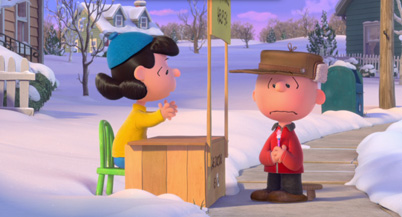Movie Review: The Peanuts Movie
By Ben Gruchow
November 10, 2015
BoxOfficeProphets.com

Then there is the person who is somewhat familiar with the Peanuts comic strip and TV shows, who perhaps saw them as children and liked them, but didn’t grow up with the characters or develop much of a lasting affection for them. I fall into this camp, and I found The Peanuts Movie an odd experience; I was drawn in at the start, and there were moments and incidents that tugged at some obscure memory that made me aware I was seeing a callback to something from the franchise’s past. In this way, the movie kept me on board - up to a point. If there was ever an argument that needed to be made about how Peanuts is best suited story-wise to 25-minute TV specials instead of 90-minute features, this is it.
How do we approach said story? The Peanuts Movie doesn’t really have one. Instead, we have a series of vignettes that roughly correspond to signature moments and expressions in the series’ history: The Little Red-Haired Girl, nameless and mostly faceless, moves in across the street from Charlie Brown, and he’s instantly smitten. There is a school talent show, a school dance, a book report, many conflicts and resolutions in the classroom. There is a rhythm to this, and we can sense a general shape to the larger storyline well in advance of each beat, but there really is the sense by the end that this could go on forever, and the potential/inevitable Peanuts Movie sequel could more or less pick up right where this one left off.
This is, of course, accurate to the temperament of the comic strip, where a new story was generated every day or every week. And so the film establishes a fairly consistent routine: Charlie Brown encounters an opportunity to impress the Little Red-Haired Girl, does much work and preparation to excel at the opportunity, and then…well, I’ll leave you to discover the resolutions for yourself. Suffice to say that if there was a pattern of success, he would impress the Little Red-Haired Girl right away, and the credits would roll at about the half-hour mark.
The other branch of the story involves Charlie’s beagle Snoopy, and his continuing efforts to essentially outdo himself in how outlandish of a story he can visualize. This establishes a tendency of both Snoopy and Charlie Brown to imagine elaborate and fanciful outcomes for story developments; in the best of these, Snoopy embarks on an imaginative sequence that recalls spy capers, and each predicament he gets into reveals a progressively weirder and funnier real-world counterpart. Until it begins to occupy an ill-fitting percentage of the movie’s runtime, it functions as effective cutaway.
This is it, as far as story; The Peanuts Movie is, like Shaun the Sheep from August, exceedingly low-stakes, and its skirmishes and scenarios are ultimately in service of a simple, positive message. This contributes to a relaxed pace and a warm, guileless tone that is by any measure far superior to a hyper-caffeinated pop culture-consuming monstrosity like…well, like Blue Sky’s stablemate Ice Age and Rio franchises.
While we’re in the habit of discussing things The Peanuts Movie does well enough to earn it a pass straightaway: the movie is, as mentioned, absolutely gorgeous. What director Steve Martino and art director Nash Dunnigan (of both those aforementioned franchises, by the way) have done is craft fully-realized CG environments in 3D, and populated those environments with characters that somehow come off as both three-dimensional and two-dimensional.
Shading and lighting is up to par with modern CG films, and the characters are clearly created on a computer, but their motion is more akin to the staccato rhythm of stop-motion animation, and they move and pose and talk in ways that never betray the two-dimensional visual on the page. It’s warm, familiar, and comfortable; we accept this as Peanuts without hesitation. Yet it is clearly a film that required much effort and much careful digital calibration. It’s thrilling to watch.
The downside to all of this conviction and faithfulness is that the movie would be borderline-incomprehensible to someone who is unfamiliar with the Peanuts comic strip or TV series, and it would be insufferable to the non-Peanuts fan who wanders into the movie hoping to be converted. I exempt from this very little children, who are likely to be entertained by the visuals on display and the overall gentle nature of the production. It would be possible for a newcomer to follow the general incident as each one unfolds, but the tone would be totally alien. The movie is also, for all of its congeniality, not very intelligent—or at least, not willing or able to build on the character tics and traits of the strip and TV episodes to amount to something more. It exists comfortably within its plane of existence, but never comes close to transcending or challenging it.
This is the context that The Peanuts Movie shares with the other 2015 animated films that dealt in the same directness and clarity of vision: Shaun the Sheep and Inside Out. Both of those were smarter and funnier films, and - in different ways - equally as beautiful to look at. To keep the spirit and tone of Schulz’s creation is indeed very important, but that does not mean that a version of The Peanuts Movie with greater depth and invention and surprise could not have been made. What we have here is worthy, and appropriate; you will not dislike yourself for watching it as an adult any more than you would as a child. The bar for exceptional was set unusually high this year.